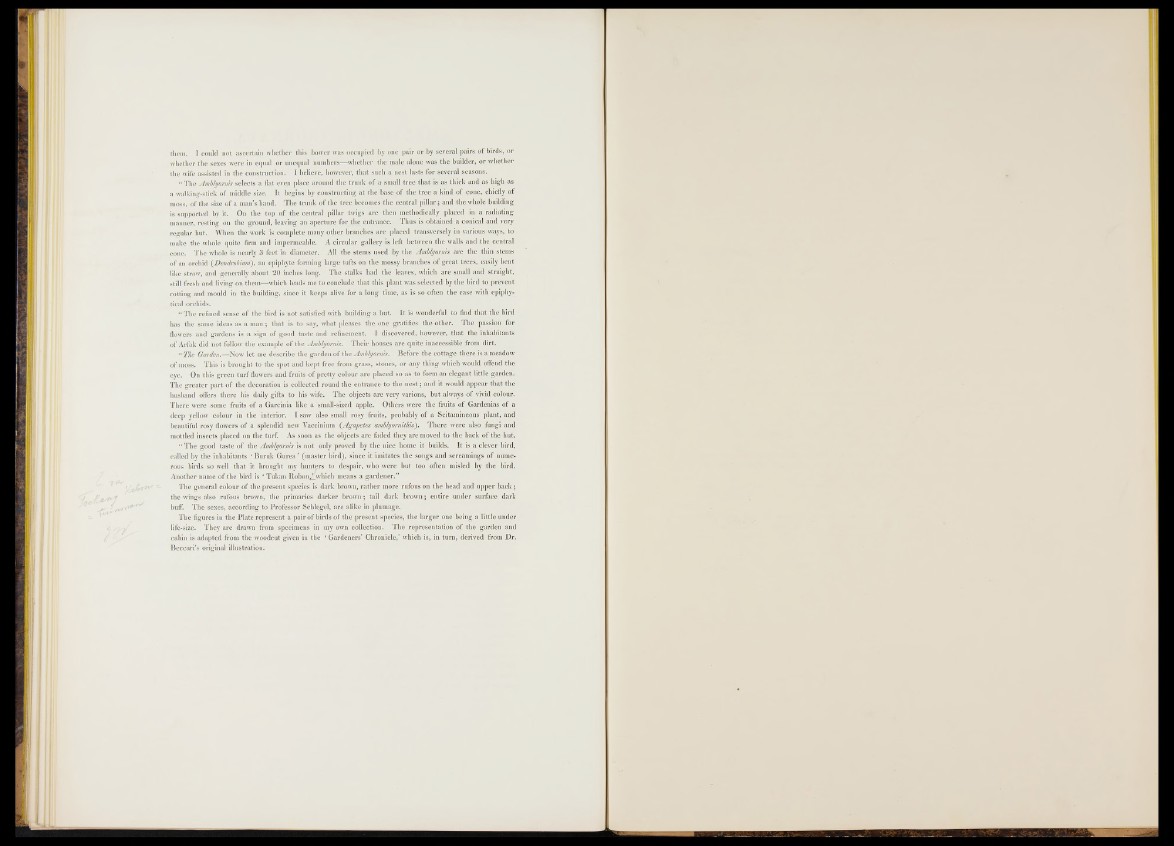
them. I could not ascertain whether this bower was occupied by one pair or by several pairs o f birds, or
whether the sexes were in equal or unequal numbers—whether the male alone was the builder, or whether
the wife assisted in the construction. I believe, however, that such a nest lasts for several seasous.
“ The Amblyomis selects a flat even place around the trunk o f a small tree that is as thick and as high as
a walking-stick o f middle size. It begins by constructing at the base o f the tree a kind o f cone, chiefly o f
moss, of the size of a man’s hand. The trunk o f the tree becomes the central pillar; and the whole building
is supported by it. On the top o f the central pillar twigs are then methodically placed in a radiating
manner, resting on the ground, leaving an aperture for the entrance. Thus is obtained a conical and very
regular hut. When the work is complete many other branches are placed transversely in various ways, to
make the whole quite firm and impermeable. A circular gallery is left between the walls and the central
cone. The whole is nearly 3 feet in diameter. All the stems used by the Amblyomis are the thin stems
of an orchid (Dendrobium) , au epiphyte forming large tufts on the mossy branches o f great trees, easily bent
like straw, and generally about 20 inches long. The stalks had the leaves, which are small and straight,
still fresh and living on them—which leads me to conclude that this plant was selected by the bird to prevent
rotting and mould in the building, since it keeps alive for a long time, as is so often the case with epiphytical
orchids.
“ The refined sense of the bird is not satisfied with buildiug a hut. It is wonderful to find that the bird
has the same ideas as a man ; that is to say, what pleases the one gratifies the other. The passion for
flowers and gardens is a sign o f good taste and refinement. I discovered, however, that the inhabitants
of Arfak did not follow the example o f the Amblyomis. Their houses are quite inaccessible from dirt.
“ The Garden.—-Now let me describe the garden o f the Amblyomis. Before the cottage there is a meadow
o f moss. This is brought to the spot and kept free from grass, stones, or any thing which would offend the
eye. On this green turf flowers and fruits o f pretty colour are placed so as to form an elegant little garden.
The greater part o f the decoration is collected round the entrance to the nest; and it would appear that the
husband offers there his daily gifts to his wife. The objects are very varions, but always of vivid colour.
There were some fruits of a Garcinia like a small-sized apple. Others were the fruits o f Gardenias of a
deep yellow colour in the interior. I saw also small rosy fruits, probably of a Scitamineous plant, and
beautiful rosy flowers of a splendid new Vaccinium (Agapetes amblyornitlm). There were also fungi and
mottled insects placed on the turf. As soon as the objects are faded they are moved to the back o f the hut.
“ The good taste of the Amblyomis is not only proved by the nice home it builds. It is a clever bird,
called by the inhabitants ‘ Buruk Gurea ’ (master bird), since it imitates the songs and screamings o f numerous
birds so well that it brought my hunters to despair, who were but too often misled by the bird.
Another name of the bird is ‘ Tukan Robon¿.which means a gardener,’’
The general colour o f the present species is dark brown, rather more rufous on the head and upper back;
the wings also rufous brown, the primaries darker brown; tail dark brown; entire under surface dark
buff“. The sexes, according to Professor Schlegel, are alike in plumage.
The figures in the Plate represent a pair o f birds of the present species, the larger one being a little under
life-size. They are drawn from specimens in my own collection. The representation o f the garden and
cabin is adapted from the woodcut given in the ‘ Gardeners’ Chronicle,’ which is, in turn, derived from Dr.
Beccari’s original illustration.